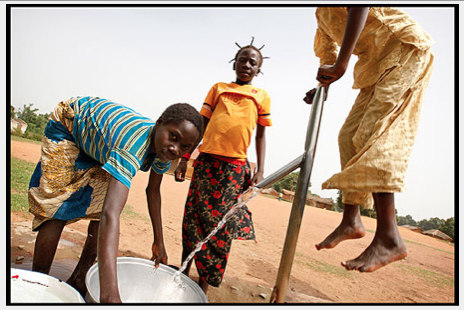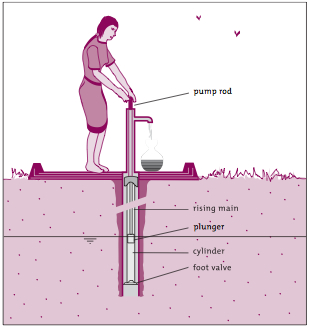Handpumps
Many different kinds of handpumps are frequently installed on hand-dug wells and boreholes in rural areas, including many drought-prone areas. They facilitate a contamination-free method to extract water, but historically handpump functionality has been negatively affected by numerous issues related to user operation & maintenance, which in turn has resulted in a large percentage of handpumps that do not work. However techniques to improve sustainability of handpump installations are possible.
Household-level handpumps, like the Rope pump or the Canzee pump, are relatively cheap options for households to abstract water from a depth of more than 7 m. The rope pump uses washers on a rope that lift up the water through a rising main. The rope is transported down into the well using a rotating wheel at the surface. When turning the wheel, the pump operator lifts the washers and with them the water from the well. The structure is completed with an apron around the pump, a pump supporting construction, and an outlet through which the water flows into a bucket or can. A ]]Canzee pump]] has two PVC tubes (with differring diameters) are used - one inside the other - with non-returning valves on the bottom side. When lowering the inside tube, the water enters in from the outside tube. When lifting the inside tube, its bottom valve closes and the water is lifted from the well. At the same time, the bottom valve of the outer tube opens and water flows into the pump. When the inside tube is lowered again, the process is repeated.
Contents
Suitable conditions
Overall, it seems sensible that handpumps should be installed only when a viable sustainable handpump option has been shown to work in the area.
Direct action handpump:
- Range of depth: 0–12 m.
- Yield: 0.25–0.42 litres/s at 12 m depth.
- Area of use: Rural and low-income periurban areas, where groundwater tables are within 12m of the surface.
Construction, operations and maintenance
There are many different types of handpumps. However most of them are positive displacement pumps and have reciprocating pistons or plungers. There are suction pumps, low lift pumps, direct action pumps, intermediate life pumps, and high lift pumps. For details on these types, look them up in Technology notes (by WaterAid).
Direct action handpumps, for example, are usually made of PVC and other plastics, and are installed on boreholes of limited depth. A plunger is attached to the lower end of a pump rod, beneath the groundwater level. The user moves the pump rod in an up-and-down motion, using a T-bar handle. On the up-stroke, the plunger lifts water into the rising main, and replacement water is drawn into the cylinder through the foot valve. On the down- stroke, the foot valve closes, and water passes through a one-way valve in the plunger and is lifted on the next upstroke.
Because direct action handpumps have no mechanical advantage, such as the lever or fly-wheel of a deep-well handpump, direct action pumps can only be used to depths from which an individual can physically lift the column of water (about 12 m). However, the mechanical simplicity, low cost and lightweight construction makes these pumps well equipped to meet O&M objectives at the village level.
The pump is operated by moving a handle up and down. As the plunger is located underwater, no priming is needed. Adults, and even children, can pump the water, although if the water table is below 5 m, this may be difficult for children. The pump stand and site must be kept clean.
Maintenance
Maintenance of direct action pumps is relatively simple and can be taught to users or caretakers, sometimes within a few hours. For preventive maintenance, usually only one or two people are needed. Daily activities consist of checking the pump performance and the appearance of the water (if it is cloudy with silt, the borehole must be cleaned). Annually, the pump should be taken apart and checked. Small repairs include replacing worn cupseals and washers, straightening bent pump rods, and replacing corroded lock nuts. To carry out major repairs (e.g. a broken pump rod or rising main, cracks in the welding of metal parts), skilled help may be needed. O&M can be organized at community level, and since maintenance is relatively simple, good organization will result in a reliable service.
Potential problems
- Worn washers, plungers and foot valve parts
- Abrasion of the seal on the PVC cylinder and between the pump rod and rising main
- Broken or damaged handles
- The maximum lift is limited to about 12 m.
- The force needed to pump the water may be too great for children, especially if the water table is below 5 m.
Costs
Direct action handpump, Initial cost: From about US$100 to over $900 (1985 prices). Models suitable for village level O&M cost less than US$150.
Field experiences
References manuals, videos, and links
- Pumps. Different kinds of pumps. PRACTICA Foundation.
Acknowledgements
- Brikke, François, and Bredero, Maarten. Linking technology choice with operation and maintenance in the context of community water supply and sanitation: A reference document for planners and project staff. World Health Organization and IRC Water and Sanitation Centre. Geneva, Switzerland 2003.
- Szánto, Gábor L. et al. Drinking Water Decision Support Tool. PRACTICA Foundation. 2011.
- CARE Nederland, Desk Study Resilient WASH systems in drought prone areas. October 2010.


